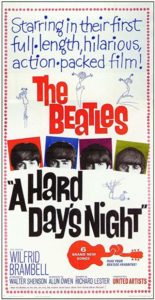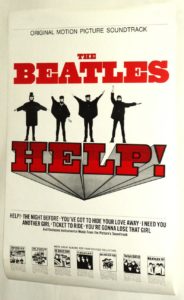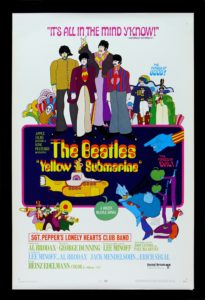
Let’s face it, the lives of Boomer kids of the 60’s were ruled by four lads from Liverpool that none of us ever hoped to meet in person. Whether it was singing their songs on the way to school, carrying their faces plastered all over our lunchboxes, or buying their 45’s, we personally generated lots of publicity and profits for them and their various business partners.
Those business partners included the English and Hollywood movie industries. There were three successful films which we all have memories of excitedly watching during the Decade of Change.
The first Beatles film to come out was A Hard Day’s Night, released at the very height of Beatlemania in 1964. It was a British film which was presented as a “mockumentary,” a style later copied brilliantly by the Monty Python gang in their depiction of The Rutles. The movie portrayed humorously a couple of days in the life of the Liverpudlians, complete with attempts to escape adoring fans.
The movie is notable for its other actors. Paul’s grandfather is played by Wilfrid Brambell, who was the star of a hit British TV show called Steptoe and Son. It would later inspire the American series Sanford and Son. It also had a brief appearance by an unknown actress named Patty Boyd, who would be Mrs. George Harrison within eighteen months.
Oh, another extra was filmed, a young British lad by the name of Phil Collins.
One of the reasons the film was such a hit is because the boys never took themselves too seriously. That would pretty much be their trademark throughout their existence as a group.

The smash success of their first film made a second one mandatory. This would be Help!, released the next year in 1965. We got to see the Beatles in color as they romped it up.
The plot, such as it was, involved Ringo having a ring stuck on his finger which was used in human sacrifice rites by a Thuggee cult. The remainder of the movie involves the Thugs chasing down Ringo as he desperately tries to get that blasted ring off of his finger before he is offered up to their gods.
The movie involves pubs, the Bahamas, a mean tiger, exploding curling rocks, and a few other oddities. And it was a smash hit.
John Lennon would later say that the boys were doing some of their first experimentation with drugs, smoking lots of marijuana between takes. For better or worse, it added to the frivolity and the lack of self-importance which made the movie fun.
The next film would be a big, stinking bomb. Magical Mystery Tour was a 1967 made-for-TV mess that Paul was ramrodding, to the rest of the boys’ reluctance. Paul’s being the boss here was a factor in the group’s eventual breakdown, as the cohesiveness that was felt when all four agreed on something was replaced by one of them attempting to do the thinking of the rest.
Paul was attempting to capture the spirit of Ken Kesey’s LSD-addled Merry Pranksters as they made their way across the US in 1964 in a psychedelically-painted schoolbus. The movie’s message was heavily bowdlerised for the staid BBC, and thus ended up making little sense. Perhaps a few tabs would have helped. Despite the movie’s failure, the album it inspired was still a hit.

In 1968, Yellow Submarine showed us the Beatles in cartoon form. These weren’t the same moptops we saw in the ABC Saturday morning show. No, these were older, wiser, hairier, spacier Beatles who traveled throughout a very weird world resembling, yes, an LSD trip.
The Blue Meanies were threatening life as we know it by turning Sergeant Pepper’s Lonely Hearts Club Band into statues and draining the world of color. It’s up to the Fab Four to save the day, and they make their way to the underwater home of the frozen band in order to free them and restore color, beauty, and happiness to the cosmos.
Like the earlier animated series, the voices of the Beatles were actually provided by other actors. But the dialog was razor-sharp, and made clever references to the group’s latest music. It proved to be a hit, perhaps, like The Rocky Horror Picture Show, best understood with the help of medication. 😉
The group made one last film,1969’s Let It Be, which documented a breakup. It was meant to show the creative forces behind the scenes involved in making an album, instead, it captured everyone in the worst light possible. It was simply bad timing. However, the rooftop concert scene at the end is worth watching.
Thus ended the era of the real-live Beatles at the box office. Later attempts to capture the group’s music and stories have been pretty lame. At presstime Nowhere Boy is enjoying critical popularity with its limited release, perhaps it might buck the trend.
However, we who were lucky enough to experience the 60’s can recall a magical time when we were seeing the Beatles on the silver screen while the group was off somewhere else recording even more timeless, truly great music.